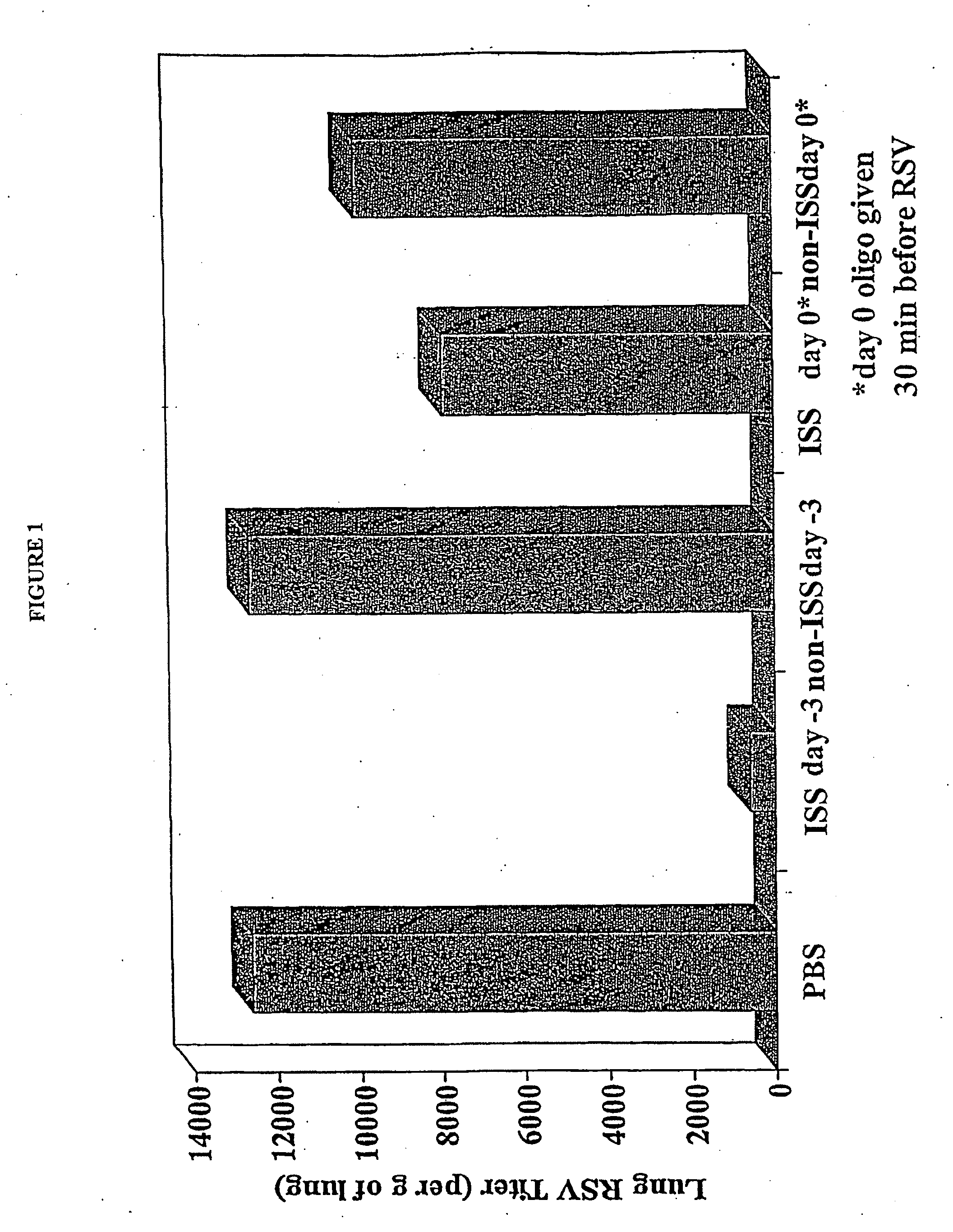Methods of preventing and treating respiratory viral infection using immunomodulatory polynucleotide sequences
a technology of immunomodulatory polynucleotide and respiratory virus, which is applied in the field of immunomodulatory polynucleotides, can solve the problems of respiratory virus infection remaining a major health problem worldwide, significant loss of productivity annually, discomfort and even death, and affecting the treatment so as to prevent, and/or improve the effect of respiratory virus infection, and reduce the incidence and/or severity
- Summary
- Abstract
- Description
- Claims
- Application Information
AI Technical Summary
Benefits of technology
Problems solved by technology
Method used
Image
Examples
example 1
Animal Model and Experimental Methods for Respiratory Viruses
[0114]Rat Model for RSV Infection and ISS Administration
[0115]Cotton rats, 50-100 g and 4-12 weeks old (Sigmoden hispidis) of either sex were used in these studies. All of the animals were descendants of two pair of cotton rats obtained in 1984 from the Small Animal Section of the Veterinary Research Branch, Division of Research Services, National Institutes of Health.
[0116]RSV strain A2 was purchased from the ATCC (ATCC VR26). Working stocks of this virus were prepared as described in detail by Wyde et al. (1995) Pediatr. Res. 238:543-550. ISS sequence tested for RSV experiments was 5′-TGACTGTGAACGTTCGAGATGA-3′ (SEQ ID NO:1) (phosphorothioate). Control, non-ISS sequences used were 5′-TGACTGTGAAGGTTAGAGATGA-3′ (SEQ ID NO:9) (phosphorothioate) and 5′-TCACTCTCTTCCTTACTCTTCT-3′ (SEQ ID NO:10) (phosphorothioate), as well as PBS.
[0117]Assay for RSV Viral Titer
[0118]RSV levels in virus pools and lung lavage fluids (L.F.) were de...
example 2
Local Administration of ISS Reduces RSV Viral Titer
[0119]These experiments were performed to test the effect of local administration of ISS in terms of antiviral activity against respiratory syncytial virus (RSV) in cotton rats.
[0120]On day −3 (i.e., 3 days before infection with virus), 20 cotton rats (CRs) were selected and divided into five groups of four animals. The animals in Group 1 were lightly anesthetized and 50 μL of phosphate buffered saline (PBS) was administered intranasally (IN). The CRs in Group 2 were similarly administered 150 μg of ISS (5′-TGACTGTGAACGTTCGAGATGA-3′) (SEQ ID NO:1), while the animals in Group 3 were similarly administered 150 μg of control non-ISS sequence 5′-TGACTGTGAAGGTTAGAGATGA-3′ (SEQ ID NO:9). Three days later, on Day 0, each of CRs in Group 4 were anesthetized and 150 μg of ISS was administered 1N, and the animals in Group 5 were administered, in a like manner, 150 μg of control non-ISS sequence 5′-TGACTGTGAAGGTTAGAGATGA-3′ (SEQ ID NO:9).
[0121...
example 3
Non-Local Administration of ISS and RSV Viral Titer
[0123]These experiments were performed to test the effect of non-local administration of ISS in terms of antiviral activity against RSV in cotton rats.
[0124]Twenty cotton rats were divided into 5 groups of 4 animals. Administered to these animals, either intraperitoneally (IP) or subcutaneously (SC), was PBS, immunostimulatory sequence (ISS) 5′-TGACTGTGAACGTTCGAGATGA-3′ (SEQ D NO:1) or non-ISS sequence 5′-TCACTCTCTTCCTTACTCTTCT-3′ (SEQ ID NO:10), each sequence at 150 μg / injection. On Day 0 each of these animals was inoculated IN with 100 TCID50 of RSV A2. Four days later each cotton rat was sacrificed. The lungs of each animal were removed, lavaged and assessed for RSV. The protocol is summarized in Table 3. The results from IP administration are shown in Table 4. The results from SC administration are shown in Table 5.
TABLE 3ProtocolDose ISSDayDayISSgivenISSRSVDay CRsGroupadmin.(μg / CR)givengivenSacrificedEnd-point1PBS0−3, −10Day 4R...
PUM
| Property | Measurement | Unit |
|---|---|---|
| size | aaaaa | aaaaa |
| size | aaaaa | aaaaa |
| size | aaaaa | aaaaa |
Abstract
Description
Claims
Application Information
 Login to View More
Login to View More - R&D
- Intellectual Property
- Life Sciences
- Materials
- Tech Scout
- Unparalleled Data Quality
- Higher Quality Content
- 60% Fewer Hallucinations
Browse by: Latest US Patents, China's latest patents, Technical Efficacy Thesaurus, Application Domain, Technology Topic, Popular Technical Reports.
© 2025 PatSnap. All rights reserved.Legal|Privacy policy|Modern Slavery Act Transparency Statement|Sitemap|About US| Contact US: help@patsnap.com

